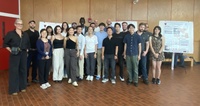Citation:
91 -, Emmert MY, Wolint P, Jakab A, Sheehy SP, Pasqualini FS, Nguyen TD, Hilbe M, Seifert B, Weber B, Brokopp CE, Macejovska D, Caliskan E, Eckardstein von A, Schwartlander R, Vogel V, Falk V, Parker KK, Gyöngyösi M, and Hoerstrup SP. 2017. “
Safety and efficacy of cardiopoietic stem cells in the treatment of post-infarction left-ventricular dysfunction – From cardioprotection to functional repair in a translational pig infarction model.” Biomaterials, 122, Pp. 48-62.
Publisher's VersionAbstract:
To date, clinical success of cardiac cell-therapies remains limited. To enhance the cardioreparative properties of stem cells, the concept of lineage-specification through cardiopoietic-guidance has been recently suggested. However, so far, only results from murine studies and from a clinical pilot-trial in chronic heart-failure (CHF) are available, while systematic evidence of its therapeutic-efficacy is still lacking. Importantly, also no data from large animals or for other indications are available. Therefore, we here investigate the therapeutic-efficacy of human cardiopoietic stem cells in the treatment of post-infarction LV-dysfunction using a translational pig-model. Using growth-factor priming, lineage-specification of human bone-marrow derived MSCs was achieved to generate cardiopoietic stem cells according to GMP-compliant protocols. Thereafter, pigs with post-infarction LV-dysfunction (sub-acute phase;1-month) were randomized to either receive transcatheter NOGA 3D electromechanical-mapping guided intramyocardial transplantation of cardiopoietic cells or saline (control). After 30days, cardiac MRI (cMRI) was performed for functional evaluation and in-vivo cell-tracking. This approach was coupled with a comprehensive post-mortem cell-fate and mode-of-repair analysis. Cardiopoietic cell therapy was safe and ejection-fraction was significantly higher when compared to controls (p = 0.012). It further prevented maladaptive LV-remodeling and revealed a significantly lower relative and total infarct-size (p = 0.043 and p = 0.012). As in-vivo tracking and post-mortem analysis displayed only limited intramyocardial cardiopoietic cell-integration, the significant induction of neo-angiogenesis (∼40% higher; p = 0.003) and recruitment of endogenous progenitors (∼2.5x higher; p = 0.008) to the infarct border-zone appeared to be the major modes-of-repair. This is the first report using a pre-clinical large animal-model to demonstrate the safety and efficacy of cardiopoietic stem cells for the treatment of post-infarction LV-dysfunction to prevent negative LV-remodeling and subsequent CHF. It further provides insight into post-delivery cardiopoietic cell-fate and suggests the mechanisms of cardiopoietic cell-induced cardiac-repair. The adoption of GMP-/GLP-compliant methodologies may accelerate the translation into a phase-I clinical-trial in patients with post-ischemic LV-dysfunction broadening the current indication of this interesting cell-type.
